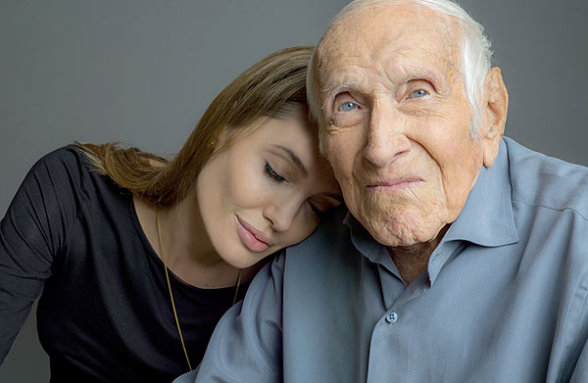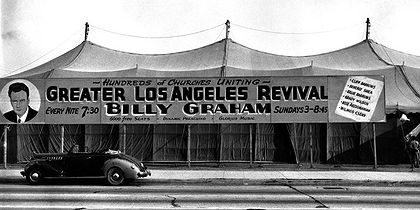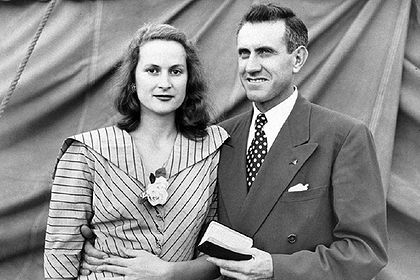A review of the film ‘Unbroken’: “We all need heroes. We want someone to admire, but often, we only find them in fiction. Angelina Jolie met a real one, who has recently left us.”
 Angelina Jolie met Zamperini before he died.
Angelina Jolie met Zamperini before he died.
We all need heroes. We want someone to admire, but often, we only find them in fiction. Angelina Jolie met a real one, who has recently left us. Louis Zamperini was a US athlete who beat a record in the Berlin Olympics in 1936, watched on by Hitler. He flew a bomber in the Second World War, which crashed into the Pacific, where he survived on a lifeboat for 47 days. He was rescued by the Japanese and imprisoned in a concentration camp for two years. His story is brought to us in the film “Unbroken”.
However, the film doesn’t say that after it was all over, he felt disillusioned and unhappy. He was an alcoholic by 1949, when he went into the tent in which Billy Graham was preaching during a campaign in Los Angeles. He became a Christian through his wife. He later went back to Japan and tried to make peace with his sadist gaoler. Something of this is mentioned in a postscript at the end of the film, after showing the real Zamperini carrying the Olympic torch in Nagano, at the beginning of the 1998 Winter Games.
The person who does tell the whole story, is the author of the book on which the film is based, Laura Hillenbrand. For Zamperini, what happened in the tent where he heard Billy Graham speak was so important that he would pray that the book would say something about the Gospel. In a way, God answered his prayers. Hillenbrand speaks of his conversion and the change that it made in his life, but she does not understand the Gospel. She explains this “born again Christianity”, as the result of the potential that lies in all of us.
The script is based on the book, but it has undergone a number of changes. It has passed through the hands of great professionals including William Nicholson – the scriptwriter of the film on C.S. Lewis, “Shadowlands”, as well as “Gladiator” and “Les Miserables” –, Richard LaGravanesse – who wrote “The Fisher King” and adapted “The Bridges of Madison County” – and even the Coen brothers – who also appear in the credits as scriptwriters–.
When Angelina was asked whether it was a deliberate choice not to refer to his religious conviction as a born-again Christian, she said that she had consulted Louis and the book’s author and that they had reached the conclusion that it wouldn’t be right to summarise his life after the liberation in ten minutes, not wanting to speed through each part of his life. In any case, Jolie believes that his faith, which was the most important thing, is reflected without focusing one religion in particular.
THE STORY OF A SURVIVOR
“Unbroken” is a story about survival, told using a classic rhythm, which shows that Angelina Jolie is not just a competent actress, but that she also has her own vision – as she showed in her debut film “In the Land of Blood and Honey” (2011), set during the Bosnian War–. Her perspective as a woman, as in the case of Kathryn Bigelow, is not at all sentimental, but violent. She observes with pause the cruel torture that Zamperini underwent. Such bodily humiliation and mortification, throughout such an ordeal, reminds us of “The Passion of the Christ” (2004). At times, certain images are of an unbearable cruelty, making ellipsis impossible.
 Angelina Jolie directs a war film, inhabited mainly by men.
Angelina Jolie directs a war film, inhabited mainly by men. This is a war film, inhabited mainly by men, among whom Jolie seems evidently at ease. It sometimes comes close to the propaganda films that were made in the 1940s, warning against the “yellow peril”. Its style is also surprisingly classic – none of the fast editing seen in the films in which Jolie tends to star–. Although critics have not been very enthusiastic, they all agree that the initial air attack works particularly well due to the attention to detail in the filming.
The performance of actors, such as Jack O’Connell, has also drawn attention to this film. Although they are not big names, they bring authenticity to a story which otherwise borders on a hagiography. The information is nevertheless all correct. Zamperini avoided juvenile delinquency by concentrating on sport; he met Hitler at the Olympics; and his brother told him that “a lifetime of glory is worth a moment of pain”. They survived on a raft, as shown in the film, after which they were confined on “Execution Island” – which earned the name because nine marines had previously been decapitated there–.
 Zamperini forgave Watanabe.
Zamperini forgave Watanabe.“The Bird”, Watanabe, was indeed an army sergeant embittered by the fact that he had not been promoted to become an officer, despite his privileged background. His confrontation with Zamperini is reminiscent of the conflict between Ryuichi Sakamoto and David Bowie in the film by Nagisa Oshima, “Merry Christmas, Mr Lawrence” (1983) – based on the real-life experience of the South-African writer Laurens van der Post–. Watanabe was pursued as a war criminal, going into hiding for seven years. When Zamperini returned to Japan, he tried to meet with him, but Watanabe refused. The letter that Zamperini wrote to him said:
“I committed my life to Christ. Love replaced the hate I had for you. Christ said ‘Forgive your enemies and pray for them’.”
AMAZED BY FORGIVENESS
The end of this story is very different from that of another film that also came out last year, “Railway Man”, which is based on the experience of a British military engineer, Eric Lomax, who was tortured as a prisoner of war in a Japanese camp. There, prisoners were forced to work on the line of the so-called “Death Railway” between Thailand and Burma during the Second World War. The man who tortured him, Takashi Nagase, repented for what he had done and Lomax met with him near the bridge on the river Kway, in 1993.
 Eric Lomax was also a prisoner held by Japan, in World War II.
Eric Lomax was also a prisoner held by Japan, in World War II.The fact is that we “live burdened by traumas, past pain, the harm that someone once inflicted on our bodies or spirits” –Carmen Lobo argues in her commentary on “The Railway Man”–. The story of the couple, played by Colin Firth and Nicole Kidman in this film, moved me more than “Unbroken”. Their precious idyll is devastated by the ghosts of a past that burst in on them with the news of the appearance of Eric’s torturer as an agent of reconciliation.
However, the Eric Lomax biopic conceals more than the film on Zamperini. While “Unbreakable” cuts the story short before the hero is broken and finds new life through his commitment to Christ, “The Railway Man” does not talk about Lomax’s first marriage with a devout Christian, Nan – with whom he had two girls, Linda and Charmaine –, before marrying Patti. They also underwent a form of torture. Nan and Linda, along with Eric, have now died but Charmaine is still alive today. She survived the nightmare thanks to her Christian faith, which enabled her to be amazed by forgiveness.
I had never heard Psalm 23 resound with the power it has in the mouth of the soldier who sees Lomax being beaten. He is the author of the mysterious verses that you hear in the first scene: " At the beginning of time the clock struck one/ Then dropped the dew and the clock struck two/ From the dew grew a tree and the clock struck three/ The tree made a door and the clock struck four/ Man came alive and the clock struck five/ Count not, waste not the years on the clock/ Behold I stand at the door and knock.".
Behind the door to that room, in which he is tortured, lies the memory of his intense suffering. All of this, without showing the slightest scene of violence. The camera refuses to linger on suffering as a spectacle. Everything is subtlety and discretion in this exciting story about the difficulty of forgetting and the amazement of forgiveness, which is born from a supernatural form of love. The same love which changed Louis’ life…
THE POWER OF CONVERSION
This is the power of conversion, which my friend Ivan Mesa talks about in his article on Zamperini for the Gospel Coalition. As his colleague, Collin Hanses, I also believe that the title “Unbroken” is all wrong. The hero needed to be broken in order to be born again. As Hillenbrand says, “a singularly hopeful man now believed that his only hope lay in murder”.
 Zamperini became a Christian through a Billy Graham campaign in Los Angeles, 1949.
Zamperini became a Christian through a Billy Graham campaign in Los Angeles, 1949.Zamperini became an alcoholic, ruined after trying to get rich quick. He would not listen to the advice of his friends or his wife Cynthia. She was on the verge of filing for divorce, when in September 1949, a young Billy Graham reached Los Angeles to run an evangelism campaign over three weeks. Cynthia went along and received Christ as her Saviour. Louis did not want to participate in the “religious revival”, but one day he agreed to go. That day he went home feeling indignant, but he went for a second time and there the miracle happened.
“I dropped to my knees and for the first time in my life truly humbled myself before the Lord. I asked him to forgive me for not having kept the promises I’d made during the war, and for my sinful life. I made no excuses. I did not rationalize, I did not blame. He had said, “Whosoever shall call upon the name of the Lord shall be saved,” (Romans 10:13) so I took him at his word, begged for his pardon, and asked Jesus to come into my life”.
Louis began a new life, which led him to forgive his torturer. He spoke about his faith to young people with problems and he remained married to Cynthia until her death from cancer in 2001. He himself went to be with the Lord last year, at the age of 97. His life is not an example of the human power to forgive – as Mesa says –. On the contrary, it shows humanity’s total incapacity to conquer sin and to avoid its disastrous consequences, without the grace of God.
The instinct for survival, which kept him alive at sea and in prison, was not able to save him when he came home after the war. He discovered that his worst enemy was inside, not outside. He was a “slave to sin” (John 8:34). His conversion was not a footnote, but a preface to his new life. It reminds us of what Psalms 51:17 says: “a broken and contrite heart you, God, will not despise”. He is prepared to forgive us and He gives us the ability to forgive others.
 Zamperini with his wife Cynthia, holding a Bible, next to Billy Graham's campaign tent, in 1949.
Zamperini with his wife Cynthia, holding a Bible, next to Billy Graham's campaign tent, in 1949.C.S. Lewis said: “Everyone says that forgiveness is a lovely idea, until they have something to forgive”. Resentment is a cancer which corrodes our soul. Those who refuse to forgive might believe that they are in control of the situation, when in reality they are enslaved by it. When we forgive, we realise that we have been living in another kind of a prison – in Zamperini’s case, worse than his Japanese prison –, which we have built up inside ourselves. Only Christ can set us free. And when we forgive others, we also set other prisoners free, through the power of His Love.

Las opiniones vertidas por nuestros colaboradores se realizan a nivel personal, pudiendo coincidir o no con la postura de la dirección de Protestante Digital.
Si quieres comentar o